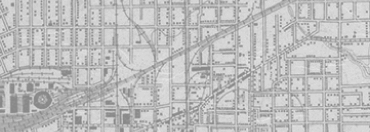


Back
Color slide transparency of Dealey Plaza after shots were fired - Towner 2
One color slide transparency taken by Jim Towner on Friday, November 22, 1963, showing people and motorcade cars in Dealey Plaza within one minute after the assassination. This image, known as Towner 2, is the second of four pictures Towner took in Dealey Plaza that day. The image shows the first two of three motorcade cars carrying national and local news photographers traveling west on Elm Street toward the triple underpass. The grassy knoll can be seen in the background to the right. In the immediate aftermath of the shooting, people in Dealey Plaza are still reacting to the shots - just beyond the yellow convertible, Bill and Gayle Newman can be seen on the grass, where they dropped when they heard shots. Police officer Clyde Haygood appears on his motorcycle, headed toward the triple underpass, and officer Edgar Smith surveys the scene with his gun drawn. In the foreground are WFAA radio employees Pierce Allman (left) and Terry Ford (right). Amateur photographer Hugh Betzner stands in front of them. The three individuals in the pergola (in the upper right area of the image) are known to be, from left to right, Abraham Zapruder, Beatrice Hester and Charles Hester (Beatrice was Zapruder's payroll clerk). The man at the far left is unidentified. Onlookers stare toward the underpass, where the president's limousine disappeared seconds before.This image was taken with a Yashica 44-LM twin-lens still camera (2015.009.0001), and is on 35mm 127 format Kodak film. The original cardboard slide mount has been removed, revealing the full image and a black border. The top and bottom edges are unevenly cut.
Color slide transparency of Dealey Plaza after shots were fired - Towner 2
11/22/1963
Film
1 15/16 × 1 15/16 in. (4.9 × 4.9 cm)
Towner Collection/The Sixth Floor Museum at Dealey Plaza
2015.009.0003
The two men beyond the yellow car, seated on a retaining wall along the sidewalk, have long been of interest to conspiracy researchers. They were not identified at the time of the assassination but were later referred to by researchers as the Umbrella Man (TUM), seated at right, and the Dark Complected Man (DCM) or the Cuban (because of his beret-style cap), seated at left. One theory suggested that TUM had a concealed weapon inside his umbrella and fired a poison dart that paralyzed President Kennedy so he couldn't evade the gunfire. Some suggested that DCM was a signal man who, using a walkie-talkie radio, was supposed to coordinate the shooting with the gunmen and communicate afterward with his fellow conspirators. In 1978 the House Select Committee on Assassinations (HSCA) published several pictures and asked for the public’s help in identifying certain individuals who were photographed in Dealey Plaza at the time of the assassination. A man contacted Texas conspiracy researcher Penn Jones saying Louie Steven Witt, a co-worker at the time, was TUM and that Witt still lived and worked in Dallas. Jones called Dallas Morning News reporter Earl Golz, then me. The three of us—accompanied by researchers Jack White, Jim Marrs and Dave Tucker, along with News photographer David Woo—went to visit Witt where he was employed. (Marrs, then a reporter for the Fort Worth Star-Telegram, had to agree with Golz not to report that TUM had been found until after the story appeared in The Dallas Morning News, otherwise he would not be told Witt's location.) Witt declined to discuss the assassination with us but said he would speak to HSCA investigators. Witt later testified to the HSCA that he was waiting to heckle the president about Kennedy's foreign policies by displaying his umbrella. Witt noted that Kennedy's father, Joseph P. Kennedy, the U.S. Ambassador to Great Britain in the late 1930s, shared British Prime Minister Neville Chamberlain's belief that appeasement was the best approach to dealing with German Chancellor Adolf Hitler. Chamberlain traditionally carried a large black umbrella but as WWII began and appeasement was seen as a failure, the umbrella came to symbolize that failure. Protestors in both England and the United States used umbrellas to protest appeasement policies then and for several decades after WWII ended. Witt had kept his umbrella and opened it for the HSCA and news cameras to demonstrate there was no gun inside. Some researchers continued to doubt Witt's story mistakenly concluding that the umbrella TUM was seen holding in the Zapruder film had fewer ribs than the one Witt showed the HSCA. Several pictures taken in the seconds before and after the assassination show both TUM and DCM, and in some it appears as if DCM had an object of some sort in his hand. When this Towner photo is magnified, there appears to be a light-colored line extending from behind DCM's head, across the dark coat of the photographer standing behind him. Some surmise that it is the antenna for a walkie-talkie, but the picture is not clear enough to identify the object. Some standard portable radios at the time, however, had extendable antennas for better reception. Careful study of the original slide does, however, reveal the line is not a scratch in the film's emulsion and must, therefore, be something extending from whatever object DCM was holding. - Gary Mack, Curator
Color slide transparency of Dealey Plaza after shots were fired - Towner 2
One color slide transparency taken by Jim Towner on Friday, November 22, 1963, showing people and motorcade cars in Dealey Plaza within one minute after the assassination. This image, known as Towner 2, is the second of four pictures Towner took in Dealey Plaza that day. The image shows the first two of three motorcade cars carrying national and local news photographers traveling west on Elm Street toward the triple underpass. The grassy knoll can be seen in the background to the right. In the immediate aftermath of the shooting, people in Dealey Plaza are still reacting to the shots - just beyond the yellow convertible, Bill and Gayle Newman can be seen on the grass, where they dropped when they heard shots. Police officer Clyde Haygood appears on his motorcycle, headed toward the triple underpass, and officer Edgar Smith surveys the scene with his gun drawn. In the foreground are WFAA radio employees Pierce Allman (left) and Terry Ford (right). Amateur photographer Hugh Betzner stands in front of them. The three individuals in the pergola (in the upper right area of the image) are known to be, from left to right, Abraham Zapruder, Beatrice Hester and Charles Hester (Beatrice was Zapruder's payroll clerk). The man at the far left is unidentified. Onlookers stare toward the underpass, where the president's limousine disappeared seconds before.This image was taken with a Yashica 44-LM twin-lens still camera (2015.009.0001), and is on 35mm 127 format Kodak film. The original cardboard slide mount has been removed, revealing the full image and a black border. The top and bottom edges are unevenly cut.
Color slide transparency of Dealey Plaza after shots were fired - Towner 2
11/22/1963
Photographs
Cameras
Grassy knoll
Eyewitnesses
Dealey Plaza
Motorcade
Police
Triple underpass
Towner, Jim
Haygood, Clyde
Allman, Pierce
Zapruder, Abraham
Hester, Beatrice
Hester, Charles
Newman, Bill
Newman, Gayle
Kodak
Dallas
Film
1 15/16 × 1 15/16 in. (4.9 × 4.9 cm)
Towner Collection/The Sixth Floor Museum at Dealey Plaza
2015.009.0003
The two men beyond the yellow car, seated on a retaining wall along the sidewalk, have long been of interest to conspiracy researchers. They were not identified at the time of the assassination but were later referred to by researchers as the Umbrella Man (TUM), seated at right, and the Dark Complected Man (DCM) or the Cuban (because of his beret-style cap), seated at left. One theory suggested that TUM had a concealed weapon inside his umbrella and fired a poison dart that paralyzed President Kennedy so he couldn't evade the gunfire. Some suggested that DCM was a signal man who, using a walkie-talkie radio, was supposed to coordinate the shooting with the gunmen and communicate afterward with his fellow conspirators. In 1978 the House Select Committee on Assassinations (HSCA) published several pictures and asked for the public’s help in identifying certain individuals who were photographed in Dealey Plaza at the time of the assassination. A man contacted Texas conspiracy researcher Penn Jones saying Louie Steven Witt, a co-worker at the time, was TUM and that Witt still lived and worked in Dallas. Jones called Dallas Morning News reporter Earl Golz, then me. The three of us—accompanied by researchers Jack White, Jim Marrs and Dave Tucker, along with News photographer David Woo—went to visit Witt where he was employed. (Marrs, then a reporter for the Fort Worth Star-Telegram, had to agree with Golz not to report that TUM had been found until after the story appeared in The Dallas Morning News, otherwise he would not be told Witt's location.) Witt declined to discuss the assassination with us but said he would speak to HSCA investigators. Witt later testified to the HSCA that he was waiting to heckle the president about Kennedy's foreign policies by displaying his umbrella. Witt noted that Kennedy's father, Joseph P. Kennedy, the U.S. Ambassador to Great Britain in the late 1930s, shared British Prime Minister Neville Chamberlain's belief that appeasement was the best approach to dealing with German Chancellor Adolf Hitler. Chamberlain traditionally carried a large black umbrella but as WWII began and appeasement was seen as a failure, the umbrella came to symbolize that failure. Protestors in both England and the United States used umbrellas to protest appeasement policies then and for several decades after WWII ended. Witt had kept his umbrella and opened it for the HSCA and news cameras to demonstrate there was no gun inside. Some researchers continued to doubt Witt's story mistakenly concluding that the umbrella TUM was seen holding in the Zapruder film had fewer ribs than the one Witt showed the HSCA. Several pictures taken in the seconds before and after the assassination show both TUM and DCM, and in some it appears as if DCM had an object of some sort in his hand. When this Towner photo is magnified, there appears to be a light-colored line extending from behind DCM's head, across the dark coat of the photographer standing behind him. Some surmise that it is the antenna for a walkie-talkie, but the picture is not clear enough to identify the object. Some standard portable radios at the time, however, had extendable antennas for better reception. Careful study of the original slide does, however, reveal the line is not a scratch in the film's emulsion and must, therefore, be something extending from whatever object DCM was holding. - Gary Mack, Curator









